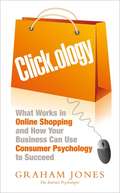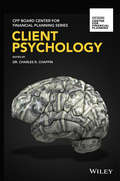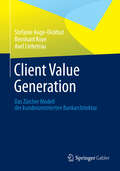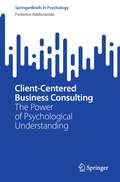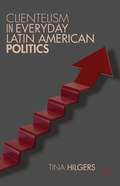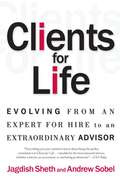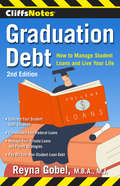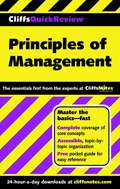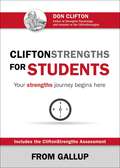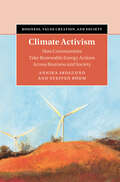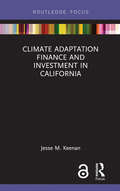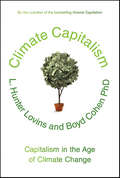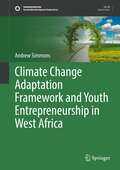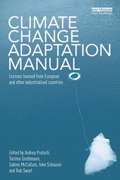- Table View
- List View
Clickology: What Works in Online Shopping and How Your Business can use Consumer Psychology to Succeed
by Graham JonesThe world of shopping is at a crossroads. While online sales are growing at runaway speed, many businesses are finding themselves left behind, discovering that what has worked so long in offline does not work online, and what works online does not necessarily translate offline: it simply doesn't click. Packed with tips, guidance and real-world case studies from online niche stores Bellabox and Facetache to the universal appeal of Groupon, and from offline discount stores Dollar Tree and Poundland to the luxury Selfridges in this informative book internet psychologist Graham Jones reveals: *Why most online shopping carts are abandoned before a purchase is ever made and how to stop this happening in your store *Why having a centrally positioned search box aids navigation and increases sales *Why offering free shipping online pays off * Why it makes sense to be sociable He also reveals the why of consumer behaviour online, how it differs from offline behaviour, and how you can use this understanding to create a store that connects with and engages your customers on both a practical and a psychological level a store that demonstrates true clickology. Using an accessible five-step CLICK system for turning clicks into dollars, the book shows how to learn from the experience of both on- and offline, and apply lessons to both. Whether you re running a small business website or that of a big corporation, whether you're operating purely online or offline too, Clickology shows you how to thrive.
Client Psychology
by Cfp Board Charles R. ChaffinA Client-Centered approach to Financial Planning Practice built by Research for Practitioners The second in the CFP Board Center for Financial Planning Series, Client Psychology explores the biases, behaviors, and perceptions that impact client decision-making and overall financial well-being. This book, written for practitioners, researchers, and educators, outlines the theory behind many of these areas while also explicitly stating how these related areas directly impact financial planning practice. Additionally, some chapters build an argument based solely upon theory while others will have exclusively practical applications. Defines an entirely new area of focus within financial planning practice and research: Client Psychology Serves as the essential reference for financial planners on client psychology Builds upon and expands the body of knowledge for financial planning Provides insight regarding the factors that impact client financial decision-making from a multidisciplinary approach If you’re a CFP® professional, researcher, financial advisor, or student pursuing a career in financial planning or financial services, this book deserves a prominent spot on your professional bookshelf.
Client Value Generation: Das Zürcher Modell der kundenzentrierten Bankarchitektur (Management for Professionals)
by Stefanie Auge-Dickhut Bernhard Koye Axel LiebetrauClient Value Generation Die Geschäftsmodelle der Banken haben ein Verfallsdatum. Differenzierung, die über die Industrialisierung hinaus geht, wird nötig. Das Machtverhältnis zwischen Bank und Kunden hat sich verschoben - Qualität und Preis-/Leistungsverhältnis der Bankdienstleistungen werden transparenter und kundenseitig konsequenter eruiert. Innovative Geschäftsmodelle fördern die Margenerosion - der Kunde braucht die Bank immer weniger. Dieses Buch legt die Eckpfeiler - u. a. effektive Kundenzentrierung und ein ,,Win-Win" zwischen Kunden und Bank - der zukünftigen Erfolgsmodelle im Banking dar und zeigt die heutigen Denkfallen und notwendige Schritte für Zukunftsfähigkeit - persönlich und für die Banken - auf. Das ,,Zürcher Modell der kundenzentrierten Bankarchitektur" aggregiert die passgenauen Instrumente zu einer Roadmap für erfolgreiche Transformation. Der Inhalt · Denkfallen und neue Spielregeln · Treiber des zukunftsfähigen Bankings und betriebswirtschaftliches Instrumentarium · Erfolgreiche Transformation · Das Zürcher Modell der kundenzentrierten Bankarchitektur Die Autoren Prof. Dr. Stefanie Auge-Dickhut ist Forschungsleiterin des Schweizer Instituts für Finanzausbildung (SIF) an der Kalaidos Fachhochschule in Zürich, Partnerin bei ,,Koye & Partner" und verfügt über langjährige Finance-Beratungserfahrung. Prof. Dr. Bernhard Koye ist Gründer und Institutsleiter des SIF, Gründer von Koye & Partner und Experte für Geschäftsmodelle & Transformations- und Changeprozesse. Axel Liebetrau ist Dozent am SIF; er gilt als einflussreichster Experte für Innovationen und Trends in Banking und Insurance im deutschsprachigen Raum und ist Gründer der ,,Banking Innovation Group" in Stuttgart. Mit einem Gastbeitrag von Charlotte Götz, ebenfalls Dozentin am SIF und Gründerin von ,,CO13 für systemisches Veränderungsmanagement".
Client-Centered Business Consulting: The Power of Psychological Understanding (SpringerBriefs in Psychology)
by Federico AddimandoThis book explores the psychology behind effective business consulting. We dive into the various factors that shape client behavior and decision-making, and we provide insights into the most effective techniques and strategies for building rapport, establishing trust, and delivering value. Whether you are a seasoned consultant looking to refine your skills, or a new consultant seeking to build a solid foundation, this book is designed to provide you with the tools and knowledge you need to succeed in the dynamic and demanding world of business consulting.
Clientelism in Everyday Latin American Politics
by Tina HilgersIn Latin America and beyond, societies are deeply unequal, the poor are marginalized, and states face continuous fiscal shortages and real or potential political instability. In this context, democracy functions imperfectly. It intermeshes with clientelism, with the incongruous result that clientelism not only erodes but also accompanies and supplements democratic processes. Armed with evidence of these complex interactions, this book improves understandings of how and why clientelism endures and why state policy is often ineffective. Political scientists and sociologists, the contributors employ ethnography, targeted interviews, case studies, within-case and regional comparison, thick descriptions, and process tracing. They write from political economy and institutionalist, principal- and agent-centered perspectives.
Clients First
by Joseph Callaway Joann CallawayHow honesty, competency, and caring will make you richThrow out the sales manual. Get off the motivation elevator. Clients First is a two word miracle that can change your life. This book outlines a powerful path to riches that authors Joseph and JoAnn Callaway used to sell a billion dollars in real estate in just ten years--a feat never before achieved. Here, they explain the three keys to putting your clients first that helped them create one of the most successful realty firms in the U.S. Each of the three keys is important and can stand on its own. However, the success you can achieve when following the Clients First program can only be reached when all three keys are used in coordination.Explains how honesty ensures a strong client relationshipDetails the ways in which competency pervades all aspects of a client's perception of youShows how being a caring individual can win over a client on a personal levelUnlock your potential by putting these to use in your life and your business.
Clients for Life
by Jagdish Sheth Andrew SobelFinally, the book that all professionals frustrated with fleeting client loyalty and relentless price pressure have waited for -- the first in-depth, client-tested guide to developing lasting business relationships. What separates extraordinary professionals from ordinary ones? Why are some professionals always drawn into their clients' inner circle of advisers, while others are employed on a one-shot basis and treated like vendors? Based on groundbreaking research, Clients for Life sets forth a comprehensive framework for how professionals in all fields can develop breakthrough relationships with their clients and enjoy enduring client loyalty. Drawing on insights from extensive interviews with both leading CEOs and today's most prominent client advisers, Jagdish Sheth and Andrew Sobel debunk the conventional wisdom about professional success -- "find a specialty, do good work" -- as hopelessly inadequate in a world where clients have unlimited access to information and expertise. The authors replace these tired conventions with an innovative blueprint, supported by over one hundred case studies and examples drawn from consulting, financial services, law, technology, and other fields, for how you can evolve from an expert for hire -- a commodity -- to an extraordinary adviser. Riveting portraits of both exceptional contemporary professionals and legendary advisers such as Aristotle, Thomas More, Niccolò Machiavelli, and J. P. Morgan reveal how great client relationships are achieved in practice. Readers will learn, for example, to develop selfless independence, which tempers complete emotional, intellectual, and financial independence with a powerful commitment to client needs; to become deep generalists and overcome the narrow perspective caused by specialization; to systematically build lifelong trust; and to cultivate the power of synthesis -- big-picture thinking -- that is so highly valued by clients. Acclaimed by leading management thinkers, Clients for Life clearly illustrates the most important attributes and strategies of extraordinary client advisers and shows how you can use them to enrich your own relationships. It provides sophisticated professionals with the tools and insights they need to reap the rewards of lifetime client loyalty.
Clifford Chance: Women at Work
by Boris Groysberg Katherine Connolly Stephanie MartonIt was October 2013, and global law firm Clifford Chance was coming under fire for the second time in less than a year for reputedly failing to provide a supportive work environment for its female associates. A memo entitled "Speaking Effectively" was just issued to the U.S. offices of the firm and immediately sparked controversy, as some female associates claimed that the gender-specific advice in the memo was condescending and sexist. This controversy came close on the heels of a memo released in November 2012, in which a third-year associate gave her resignation and explained why she was leaving the firm by detailing her unsustainable schedule as both a corporate lawyer and a mother to young children. Both memos were leaked on the internet, prompting bloggers, media outlets, and the public to chime in with their own opinions as to whether the firm was sexist. How should Clifford Chance have responded to these allegations? Was the firm sexist, or were things being taken out of context and blown out of proportion? If the firm determined that it needed to take heed and create a more inclusive culture that better met the needs of its female associates, where should it begin? Finally, how were the lessons learned in this case applicable to corporate America in 2014, where only 5.2% of Fortune 500 CEOs and 16.9% of board members in the United States were women?
CliffsNotes Graduation Debt
by Reyna GobelWith updated information that reflects the myriad changes in the student loan industry that affect students and their parents burdened with student loan debt, CliffsNotes Graduation Debt, Second Edition provides a step-by-step road map for effectively managing student loan debt and having a successful financial life. Reyna Gobel has accumulated tens of thousands of dollars in student loans, recovered from student loan default, and set herself on a mission to help others who face a seemingly insurmountable student loan burden, with a powerful message about taking a step-by-step approach and not being overwhelmed by the sheer weight of student loan debt. Divided into small subsections geared toward those neck-deep in debt, this book is easily digestible to students who aren't inclined to focus on their finances. Readers are encouraged to take action steps, such as finding long-lost student loans that may have gone into default, discovering payment plans they can afford, consolidating loans when it makes sense to do so, saving money on eating out and groceries, improving credit scores, tweaking their debt-to-income ratios so they can buy a home, and discussing their student loan and non-student loan debt with their significant others. By the end of the book, readers will be on the road to financial stability, with extra money for vacations and other fun stuff, too.
CliffsNotes Parents' Guide to Paying for College and Repaying Student Loans
by Reyna GobelOne of the most reliable sources of college tuition strategies before, during, and after college that parents will ever find Geared toward parents who are preplanning how to effectively save for their child's future college tuition as well as last-minute tuition savings advice, this invaluable resource gives no-nonsense advice from author Reyna Gobel, a recognized expert in the field of saving for college and repaying student loans. Reyna provides guidance on 529 college tuition savings plans, additional ways to save for college without breaking the bank, and repaying student loans that parents might have acquired. One of the best, most reliable sources of college tuition strategies before, during, and after college that parents will ever find!
CliffsQuickReview Principles of Management
by Ellen BenowitzCliffsQuickReview course guides cover the essentials of your toughest subjects. Get a firm grip on core concepts and key material, and test your newfound knowledge with review questions.Whether you're a new managerial professional or a student who's decided upon a career in business, government, or educational management, CliffsQuickReview Principles of Management can help. This guide provides a valuable introduction to the concepts of management and business. In no time, you'll be ready to tackle other concepts in this book such asPlanning and organizingStaffing and directingManaging changeDecision making and problem solvingMotivating and communicatingCliffsQuickReview Principles of Management acts as a supplement to your other learning material. Use this reference in any way that fits your personal style for study and review -- you decide what works best with your needs. You can flip through the book until you find what you're looking for -- it's organized to gradually build on key concepts. Or, here are just a few other ways you can search for topics:Use the free Pocket Guide full of essential informationGet a glimpse of what you'll gain from a chapter by reading through the Chapter Check-In at the beginning of each chapterUse the Chapter Checkout at the end of each chapter to gauge your grasp of the important information you need to knowTest your knowledge more completely in the CQR Review and look for additional sources of information in the CQR Resource CenterUse the glossary to find key terms fast.With titles available for all the most popular high school and college courses, CliffsQuickReview guides are a comprehensive resource that can help you get the best possible grades.
CliftonStrengths for Students: Your Strengths Journey Begins Here
by Gallup<p>College is a chance for you to start fresh. You get to learn and grow in ways that will amaze you. You get to write your own story. <p>So what do you want your college story to be? <p>As a student, you have the opportunity every day to search for patterns in your actions, learn from them and use them to make the most of your life experiences, now and in the future. To do that, you need a solid understanding of where and when you’re at your best: your strengths. <p><i>CliftonStrengths for Students</i> will give you suggestions for developing and using your strengths in college and in the real world. If you understand and apply your strengths, your college journey — and the rest of your life — will be happier, more fulfilling and more successful. That’s the point of developing your strengths. When you do more of what you do best, you build your life around your areas of greatness. <p>So let’s get started. Your strengths journey begins here!</p>
Climate Action Upsurge: The Ethnography of Climate Movement Politics (Routledge Advances in Climate Change Research)
by James Goodman Rebecca Pearse Stuart RosewarneIn the late 2000s climate action became a defining feature of the international political agenda. Evidence of global warming and accelerating greenhouse gas emissions created a new sense of urgency and, despite consensus on the need for action, the growing failure of international climate policy engendered new political space for social movements. By 2007 a ‘climate justice’ movement was surfacing and developing a strong critique of existing official climate policies and engaging in new forms of direct action to assert the need for reduced extraction and burning of fossil fuels. Climate Action Upsurge offers an insight into this important period in climate movement politics, drawing on the perspectives of activists who were directly engaged in the mobilisation process. Through the interpretation of these perspectives the book illustrates important lessons for the climate movement today. In developing its examination of the climate action upsurge, the book focuses on individual activists involved in direct action ‘Climate Camps’ in Australia, while drawing comparisons and highlighting links with climate campaigns in other locales. The book should be of interest to scholars and researchers in climate change, environmental sociology, politics, policy and activism.
Climate Action in Miami
by Rosabeth Moss KanterThe Miami metropolitan area is a global epicenter of climate risk from heat and sea level rise, but leaders have only recently mobilized for action to respond to this systemic challenge. Resilient 305 began a collaboration across officials in the cities of Miami and Miami Beach and Miami-Dade County, with some community leaders, but action has been slow. The case identifies the actions and concerns of (a) public sector officials (Mayors and new Chief Resilience Officers), concerned with infrastructure; (b) community activists (grass roots advocacy organizations) concerned with immediate resident issues like electric utility bills in a region with large income disparities; and (c) business leaders (real estate developers and climate technology entrepreneurs) who seek growth and economic returns. Can their interests be aligned, and new collaborations forged to accelerate climate action for both short-term and longer-term goals?
Climate Activism: How Communities Take Renewable Energy Actions Across Business and Society (Business, Value Creation, and Society)
by Steffen Böhm Annika SkoglundWhat is activism? The answer is, typically, that it is a form of opposition, often expressed on the streets. Skoglund and Böhm argue differently. They identify forms of 'insider activism' within corporations, state agencies and villages, showing how people seek to transform society by working within the system, rather than outright opposing it. Using extensive empirical data, Skoglund and Böhm analyze the transformation of climate activism in a rapidly changing political landscape, arguing that it is time to think beyond the tensions between activism and enterprise. They trace the everyday renewable energy actions of a growing 'epistemic community' of climate activists who are dispersed across organizational boundaries and domains. This book is testament to a new way of understanding activism as an organizational force that brings about the transition towards sustainability across business and society and is of interest to social science scholars of business, renewable energy and sustainable development.
Climate Adaptation Finance and Investment in California (Routledge Focus on Environment and Sustainability)
by Jesse M. KeenanThis book serves as a guide for local governments and private enterprises as they navigate the unchartered waters of investing in climate change adaptation and resilience. This book serves not only as a resource guide for identifying potential funding sources but also as a roadmap for asset management and public finance processes. It highlights practical synergies between funding mechanisms, as well as the conflicts that may arise between varying interests and strategies. While the main focus of this work is on the State of California, this book offers broader insights for how states, local governments and private enterprises can take those critical first steps in investing in society’s collective adaptation to climate change.
Climate Adaptation for Architects: A Design Toolkit
by Allison AndersonArchitecture must adapt to protect people from the threat of climate change. About half of the world’s population lives in contexts that are highly vulnerable to climate change as hazards continue to intensify, with global disasters projected to reach 560 events per year by 2030, or 1.5 events every day. The accelerating frequency and intensity of disasters underscores the urgency to prepare for severe events to protect people, communities, and essential systems but also to protect the environment which provides shelter, livelihoods, cultural heritage, and public functions. This book provides a comprehensive reference of climate adaptation design tactics and a toolkit for adaptation to shocks and stresses, outlining the process for architects and designers to: Understand the risks posed by climate change to the built environment. Reduce the risks to people and the built environment from natural hazards. Reduce human vulnerability to shocks and stresses by strengthening resilience and adaptive capacity. Design the built environment to adapt to changes over its lifetime. Design buildings and cities to reduce dependence on fossil fuels. Preserve biodiversity and support natural resources. Climate Adaptation for Architects presents 45 adaptation tactics responding to the most consequential effects of climate change: heat, water, wind, and resource scarcity. Each chapter includes images, a definition, background information, key design considerations, potential impacts, and resources for further information. This is a valuable resource for every architect, landscape architect, urban planner, developer, and policymaker.
Climate Capitalism
by L. Hunter Lovins Eban GoodsteinOn October 5, 2011, L. Hunter Lovins participated in The National Climate Seminar, a series of webinars sponsored by Bard College's Center for Environmental Policy. The online seminars provide a forum for leading scientists, writers, and other experts to talk about critical issues regarding climate change. The series also opens a public conversation, inviting participants to ask questions and contribute their own thoughts. Lovins is President and founder of Natural Capitalism Solutions (NCS / www.natcapsolutions.org). NCS works with businesses, governments, and civil society to develop practices that are sustainable for both people and the environment. Her lecture focused on ways that the United States can pull itself out of the current recession, while preserving natural and human capital. This E-ssentialis an edited version of Lovins' talk and the subsequent question and answer session. While some material has been cut and some language modified for clarity, the intention was to retain the substance of the original discussion.
Climate Capitalism
by Peter Newell Matthew PatersonConfronting climate change is now understood as a problem of 'decarbonising' the global economy: ending our dependence on carbon-based fossil fuels. This book explores whether such a transformation is underway, how it might be accelerated, and the complex politics of this process. Given the dominance of global capitalism and free-market ideologies, decarbonisation is dependent on creating carbon markets and engaging powerful actors in the world of business and finance. Climate Capitalism assesses the huge political dilemmas this poses, and the need to challenge the entrenched power of many corporations, the culture of energy use, and global inequalities in energy consumption. Climate Capitalism is essential reading for anyone wanting to better understand the challenge we face. It will also inform a range of student courses in environmental studies, development studies, international relations, and business programmes.
Climate Capitalism: Capitalism in the Age of Climate Change
by L. Hunter Lovins Boyd CohenBelieve in climate change. Or don't. It doesn't matter. But you'd better understand this: the best route to rebuilding our economy, our cities, and our job markets, as well as assuring national security, is doing precisely what you would do if you were scared to death about climate change. Whether you're the head of a household or the CEO of a multinational corporation, embracing efficiency, innovation, renewables, carbon markets, and new technologies is the smartest decision you can make. It's the most profitable, too. And, oh yes—you'll help save the planet. In Climate Capitalism, L. Hunter Lovins, coauthor of the bestselling Natural Capitalism, and the sustainability expert Boyd Cohen prove that the future of capitalism in a recession-riddled, carbon-constrained world will be built on innovations that cutting-edge leaders are bringing to the market today. These companies are creating jobs and driving innovation. Climate Capitalism delivers hundreds of indepth case studies of international corporations, small businesses, NGOs, and municipalities to prove that energy efficiency and renewable resources are already driving prosperity. While highlighting business opportunities across a range of sectors—including energy, construction, transportation, and agriculture technologies—Lovins and Cohen also show why the ex–CIA director Jim Woolsey drives a solar-powered plugin hybrid vehicle. His bumper sticker says it all: "Osama bin Laden hates my car." Corporate executives, entrepreneurs, environmentalists, and concerned citizens alike will find profitable ideas within these pages. In ten information-packed chapters, Climate Capitalism gives tangible examples of early adopters across the globe who see that the low-carbon economy leads to increased profits and economic growth. It offers a clear and concise road map to the new energy economy and a cooler planet.
Climate Challenges for Cities: Introduction to Issues and Actions in the United States
by Rosabeth Moss Kanter Catarina MartinezThis background Note introduces the implications of climate change (global warming) for American cities. In the U.S., partisan political divides and unaddressed economic and racial disparities in climate vulnerabilities can inhibit action. The two main fronts for action are mitigation (reducing emissions) and adaptation (preparing for change by building resilience). The Note reviews main sources of emissions - energy, buildings, transportation, waste - and examples of mitigation actions, showing differential costs and impact. Adaptation actions depend on geographic location and specific climate hazards, with resilience of infrastructure and institutions a major factor. The most risk-prone are often the least prepared. Crises tend to propel action, and foundations have facilitated adaptation capacity, but leadership challenges require cross-sector goal-setting and collaboration.
Climate Change
by Michael A. TomanOver the years, a large and growing literature on the economics of climate change has developed. Within this volume the contributors have included a wide range of journal essays that consider the impact of climate change on specific sectors; goods and services; the costs and benefits of greenhouse gas (GHG) mitigation; and policy design for mitigation, including both domestic instruments and issues related to international agreements.
Climate Change Adaptation Framework and Youth Entrepreneurship in West Africa (Sustainable Development Goals Series)
by Andrew SimmonsThis book's purpose is to highlight the development challenges and successes of implementing the Youth Climate Change Adaptation Development Framework in Sierra Leone, West Africa. Over the past decade, Sierra Leone has experienced a series of development challenges, including internal conflict and Ebola outbreaks in most recent times. The dire unemployment situation in Sierra Leone is compounded by the emergence of climate change that negatively impacts all aspects of daily life and wellbeing, and the education and training provided do not prepare young people adequately for the job market. Therefore, building youth resilience to adapt to the impact of climate change and other development problems is a significant development challenge faced by policymakers in Sierra Leone. The government, through funding from the African Development Bank (AfDB), has provided support for the implementation of a Youth Employment and Entrepreneurship Project (YEEP) to reinforce the employability of Sierra Leone Youth as well as enhance their entrepreneurship and employment skills through the development of a framework that integrates education and vocational institutions with job market demand and supply. This approach has resulted in strengthening the occupational levels in the youth population segments of the country. This book discusses the objectives and outcomes of this project, including curricula for Sustainable Construction, training of counselors and administrators, providing youths with supervisory skills, and developing tools to assess youth development institutions' weaknesses and enhance institutional capacity to deliver climate change adaption for sustainable development programmes. The book can be used by policymakers from Small Island Developing States (SIDS) and LDCs in Africa and Asia. It can be used by researchers working on Climate Change, Education, Sustainable Development, emphasising Climate Change Education for Sustainable Development in both developing and developed countries. It can also be used by practitioners involved in implementing innovations in youth development, employment, entrepreneurship, sustainable livelihoods initiatives, climate change adaptation, and mitigation. These practitioners and researchers would find this book an invaluable resource to support their work in the field.
Climate Change Adaptation Manual: Lessons learned from European and other industrialised countries
by Rob Swart Andrea Prutsch Torsten Grothmann Sabine McCallum Inke SchauserDue to the lack of success in climate change mitigation efforts, the importance of adaptation is becoming more and more apparent and is now one of the main imperatives of international research and action. However, research on adaptation is mostly not directly applicable to adaptation policy or practice, leaving a gap between scientific results and practical advice for decision makers and planners. This book seeks to address this problem and bridge the gap and should provide readers with practical and applicable information on climate change adaptation. Following an introduction, the book is organised into four main sections, each reflecting an essential component in the adaptation process. Climate change adaptation is an emerging subject area and has gained increased political and academic attention within the last decade. Whereas most books in the field focus on adaptation in developing countries, this volume provides an examination of predominantly European policy and offers inter-disciplinary insight into cutting edge knowledge and lessons learnt in a relatively new field of implementation.
